
The history of rail transport in Luxembourg began in 1846 and continues to the present day.

The history of rail transport in Luxembourg began in 1846 and continues to the present day.
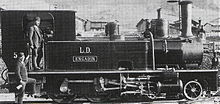
The Grand Duchy of Luxembourg belonged to the German Confederation from 1815 to 1866 as a sovereign state. The relevant treaties still remained in force after 1871 when the German Empire was founded: the Grand Duchy therefore remained a member of the German Zollverein and connected to the German Empire through a currency union, until 1918. However, until 1890, so in the period during which most of the railways were built, the Grand Duchy was connected in personal union to the Dutch monarchy. Luxembourg's neighbour, Belgium, had definitively split off from the Netherlands in 1839 with the Treaty of London. Close economic ties continued to remain between Belgium and Luxembourg.
The first half of the 19th century was strongly marked by the steam engine, the invention that allowed humans to multiply, to an unexpected extent, their capacities for production, construction, and transportation, without depending on seasonal and atmospheric conditions. Thus, the need was felt for the Grand Duchy, and especially its capital city, to be connected to neighbouring countries by the new revolutionary mode of transportation which was the railway.
Ideas for building the lines to serve the Grand Duchy were abundant at the time, and the plans and projects that emerged were not free from bias or hidden agendas.
In addition to the Luxembourgish ties with Belgium, there were British economic interests in the area. Thus, British companies and banks also studied the feasibility of railway projects that affected Luxembourg from around 1845. The Grand Duchy's finances and its financial sector were at the time too weak, to undertake railway projects itself. There was the additional problem that the city of Luxembourg was a German federal fortress, and that therefore the Prussian military stationed there prohibited the construction of a railway into the city itself. [1] : 242, 247
In 1827 a company, the Société anonyme de Luxembourg was founded in Brussels with the goal of building a navigable canal between the Maas and Moselle, a project that was already abandoned in 1830 however. From this company, and supported by British creditors, the Great Luxembourg Company / Grande Compagnie Luxembourgoise was founded in 1845, with the goal of connecting Luxembourg to its three neighbouring countries through railways. A preliminary agreement was signed on 4 June 1846, [2] but did not immediately bear fruit, as the government and the company could not reach a final agreement. A few years later, by the law of 7 January 1850, the government was authorized to negotiate with private companies. The law provided a guarantee of a minimum interest of 3%. [1] : 244
In 1853, the Luxembourger François-Émile Majerus, who had worked for a long time in Mexico as an engineer and geologist, published a pamphlet showing the great economic advantages for agriculture, trade and the Luxembourgish steel industry which would result from a Luxembourgish railway network connected to neighbouring countries.
In this context, in the mid-1850s it was necessary to take a decision. In 1854, the Compagnie du chemin de fer de Paris à Strasbourg, which would later become the Compagnie des Chemins de fer de l’Est (EST), opened the Metz–Thionville railway line. A decision had to be taken how it should be extended to the north: via Luxembourg or via Longwy.
In the second half of the 19th century, there were three diverging transport interests in Luxembourg:
To resolve these transport needs and interests, which were not all compatible with each other, several railway companies came into being, which each pursued their own goals.
With the northwards expansion of the Thionville line, the Longwy route was in the interest of Belgian and Lotharingian industrialists, who wanted to link up iron ore mines and the steel industry in the French-Luxembourgish border area. [1] : 244 Due to strategic military interests of the French government, however, the decision was taken to extend the Thionville line towards Luxembourg. Prussia on the other hand wanted a railway connection towards the east, to its own sovereign territory. [1] : 242
The Grande Compagnie Luxembourgoise had talks in 1853 with the Compagnie du chemin de fer de Paris à Strasbourg over the construction of railways in Luxembourg, and the Crédit immobilier de Paris bank declared its willingness to finance the project. (The Compagnie du chemin de fer de Paris à Strasbourg became the Compagnie des Chemins de fer de l’Est (EST) that same year.) With this, the extension of the cross-border segment of the Thionville–Luxembourg line seemed secure. Since EST was pursuing the competing project in parallel of a railway towards Belgium circumventing Luxembourg, however, the Grande Compagnie Luxembourgoise turned its back on railway construction in Luxembourg. [1] : 244
In this context, M. Daval approached the Luxembourgish government about building three railway lines, which were to lead from Luxembourg to Arlon, Thionville and Trier. Daval had founded a company for this purpose with the banker Adolphe Favier and the engineer Stéphane Jouve. After the Luxembourgish government realised that the Grande Compagnie Luxembourgoise had pulled out, EST was being reluctant due to the competing project via Longwy, and another, Prussian company that had been in talks could not bring up the funds, it started talks with Daval. This resulted in an agreement on 9 November 1855, through which the company was awarded the name of the Dutch King and Grand Duke of Luxembourg William II, as the Société royale Grand-Ducale de Guillaume-Luxembourg (German : Königlich-großherzogliche Wilhelm-Luxemburg-Gesellschaft), also Compagnie Guillaume-Luxembourg or just Guillaume-Luxembourg (GL). While the company paid the deposit, construction did not begin yet. There was then a further contract on 2 March 1857, when French funds had been secured. In the end, the Guillaume-Luxembourg lines were financed exclusively through French capital. The company became embroiled in a financial scandal, and was forced to ask the Luxembourgish government for help. [1] : 247
It therefore took until 11 August 1859, before the route to Thionville went into operation, as Luxembourg's first railway line. On that same day, a "pleasure train" with 600 passengers travelled to Paris. The same year, on 4 and 5 October, the route to Arlon was opened. [1] : 245
In the following years until 1867, Guillaume-Luxembourg opened the vast majority of the main lines of Luxembourg's network, which are still operational today. [1] : 245
Four main lines were built:
Two smaller lines were built to transport the iron ore to the blast furnaces at Dommeldange:
Due to the opposition of the local population, the lines were not laid through villages and vineyards.
The law of 7 May 1856 mandated the construction of a new direct railway line to Saarbrücken, without going via Trier. This project, the law notwithstanding, was never executed.
Operationally, the situation was challenging. There was a conflict between the GL and the Grande Compagnie du Luxembourg, which operated railways in the adjacent Belgian province of Luxembourg. The GL's lines on the other side of the border were operated by the EST railway company, which had French interests behind it. Additionally, the political situation was complex, caught between Prussia, France, and Belgium (which was supported by British interests). In 1867, the Luxembourg Crisis occurred: Napoleon III attempted to purchase Luxembourg from King William III of the Netherlands. The public in the Grand Duchy and other areas of the German Confederation protested vehemently against the plan. The crisis culminated in the Second Treaty of London in 1867, in which Luxembourg was declared "permanently neutral" on one hand, but on the other hand, the fortress of Luxembourg was abandoned and dismantled. [1] : 245
In 1862 the operation of the lines from Kleinbettingen to Luxembourg and from Luxembourg to Wasserbillig passed, once again, from the EST to the Belgian Grande Compagnie du Luxembourg, as part of an exchange for the operation on the Luxembourg–Spa railway line. However, in 1869, the EST took back control of the two aforementioned lines. [1] : 245
Another problem was that the network that had developed until 1867 led from larger cities abroad to the city of Luxembourg, in a star shape. However, the Luxembourg steel industry wanted connections between its supply and production sites and also found the tariffs of the GL to be too high. Out of this dissatisfaction, the initiative emerged to establish the Prince-Henri railway network.
Guillaume-Luxembourg was administered until 10 May 1871 by the French Compagnie des chemins de fer de l'Est. After this, the Prussians, having just won the Franco-Prussian War and subsequently having annexed the Alsace, transferred the French rights into a new Compagnie EL (Reichseisenbahn Elsass-Lothringen).
Guillaume-Luxembourg was purely a financing, construction, and railway infrastructure company that never operated a public railway itself. Even before the completion of the first line on 6 June 1857, the operation of the lines it built was leased to the Compagnie du chemin de fer de Paris à Strasbourg, later known as the Compagnie des Chemins de fer de l'Est (EST), [1] : 244 which acted as a railway operator here.
After the Franco-German War, the EST, since it now lay in the German Imperial Territory of Alsace-Lorraine, became the property of the German Empire, which reorganised this network into the Imperial Railways in Alsace-Lorraine (EL). After persistent resistance from Luxembourg, the EL then, under a treaty, took over the operating rights of the EST on the GL in Luxembourg in 1872. [4]
From 1919 onwards, the Administration des chemins de fer d’Alsace et de Lorraine (AL) took over the operating rights on the GL network, succeeding the EL, after Alsace and Lorraine had reverted to France following the First World War. In 1938, all rights of the AL were transferred to the newly established SNCF. During the Second World War, Germany occupied the Grand Duchy of Luxembourg and integrated all railways there into the Deutsche Reichsbahn. Since the establishment of the state-owned Société Nationale des Chemins de Fer Luxembourgeois (CFL) in 1946, the former GL network has been part of the CFL.
On 30 October 1858, the founding stone of the first railway station in Luxembourg City was laid down. The Fortress of Luxembourg was at this point still garrisoned by the Prussian military, and for strategic reasons the railway line could not go into the fortress. Therefore, the new station was built on the Bourbon Plateau outside of the Fortress. The Prussian military authorities demanded that it be built out of wood. The fact that the station was built outside the fortress, 1,500 metres (4,900 ft) away from the city centre, on the other side of the Pétrusse valley, is the reason for the construction of the city's viaduct, the Passerelle and the Adolphe Bridge.
On 4 October 1859, at the celebrations for the first train to depart from Luxembourg, the patriotic song "Feierwon" was sung for the first time on the steps of the town hall. This became the unofficial national anthem.
As part of the celebrations on 4/5 October, the first stone of the Passerelle bridge was laid down.
The first train from the city to Hesperange forest, Prince Henry was a passenger, was pulled by a horse. The track construction from Hesperange to the city had not progressed enough to accommodate a steam locomotive.[ citation needed ]
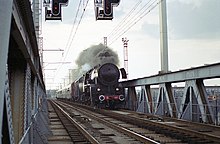

From 1864 several prominent figures put their support behind the idea of constructing a second railway line (Gürtelbahn). These included Eugène Guyot, a Brussels book printer; Simon Philippart, a Brussels banker; and François Majerus, Luxembourgish engineer. It was to go from Wasserbillig, along the Sauer, via Ettelbrück, along the Attert and the Belgian border, via Kleinbettingen to Pétange, where the centre of the new network was to be located. From Pétange it was to go on to Esch-Alzette.
On 19 March 1869, to realise this project, a law created the Société des chemins de fer Prince-Henri ("Prince Henry Railway Company"). This was named after Prince Henry of the Netherlands, the brother of King Grand Duke Wilhelm III. Prince Henry had been the Lieutenant-Governor, representing his brother, in the Grand Duchy of Luxembourg since 1850. Despite strong resistance from the competing Guillaume-Luxembourg company in conjunction with their railway company, EST, concessions were eventually granted for the Prince-Henri company. [1] : 249 This company established a network of lines, primarily radiating from Pétange, and included another line, which — albeit utilising sections of the GL network — extended in a wide arc north of the city of Luxembourg and along the eastern border of the Grand Duchy from Diekirch via Echternach and Wasserbillig to Grevenmacher. The network was gradually opened between 1873 and 1881, with some later additions. [1] : 245
In the spring of 1870, work started in two places: the line Esch-Alzette – Pétange – Steinfort and the line Pétange – Fond-de-Gras. At the same time the line Clemency – Autelbas – Arlon was started.
From 1 August 1873, the first trains ran on the new PH network:
1873–1874: From Diekirch, along the Sauer, a new project was started, the Ettelbrück-Wasserbillig line. 50 km in length, in order to avoid tunnels it went all the way through the Sauer valley up to Wasserbillig. On 20 October 1873 the Diekirch – Echternach line was inaugurated in the presence of Prince Henry, in Echternach. It was only fully functional from 8 December 1873, as there was still some work to be done. On 20 May 1874 the Echternach-Wasserbillig line started work. [5]
In 1874, the double track Pétange – Athus line was built, to create another connection to Belgium.
During 1874–1877, the customers of the ironworks were losing interest in Luxembourgish cast iron. Due to its high phosphorus contents, it was too brittle. Its price fell from 140 to 45 francs per tonne. The first crisis was unavoidable, and 40% of the ironworkers lost their jobs. The Prince-Henri company went bankrupt.
As the Prinz-Henri was not fulfilling its obligations stated in the state concessions, on 3 March 1877 the state revoked the concessions and temporarily took over the railway operations. The shareholders of the Société des chemins de fer Prince-Henri, which was dissolved, regrouped and founded the Société luxembourgoise des chemins de fer et minières Prince-Henri ("Luxembourgish Prince Henry Railway and Mine Company") in the same year. This new company took over the concessions that had been granted to the first Prince-Henri company by the state, [1] : 249 still with the abbreviation "PH".
Sidney Gilchrist Thomas and his cousin Percy Gilchrist invented a new procedure to produce steel from the phosphorus cast iron. This created a boom for Luxembourgish steel-working, and new steelworks and rolling mills sprung up.
The new PH company made efforts to finish construction of their lines. On the Steinfort - Ettelbrück section, the longest tunnel of Luxembourg (700 m) was dug and the line was in use from 20 April 1880.
On 8 August 1900, the new Pétange – Dippach – Luxembourg line opened. This was the point of PH's greatest expansion.
During 1901–1907, the air brake, invented by Westinghouse, was introduced in Luxembourg, as with other European railways. The "brakers" could be done away with.
On 4 November 1904, an industrial narrow-gauge line (1.000 mm) started operating from Grundhof to the stone quarries on the hill over Dillingen. In November 1911 it was extended to Beaufort and made accessible to passengers.
At Pétange, a "Machine fixe" was built. Wells were dug, the minerals removed from the water, and the water pumped to a water tower by the station. This water was then used in the steam engines.
The "Prince" in 1904 had about 200 km (120 mi) of railway line (of which 10 km on Belgian territory), 46 steam locomotives (6 of them for narrow-gauge lines), 68 passenger carriages and 24 baggage vans.
In May 1919, PH was made by the state to exploit the vicinal train lines: the Luxembourg – Echternach (Chareli) line and the Bettembourg – Aspelt line.
On 29 May 1927, the railway received competition. The Minette tram of the "Syndicat des Tramways Intercommunaux du Canton d'Esch" (TICE), founded in 1914 by the communes of Esch-Alzette, started service.
From 1929 onwards, profits slowly decreased until 1940.[ citation needed ]
The Luxemburg narrow-gauge railways served the country's local and regional transportation needs. They were decommissioned in the decade following the Second World War. While the Guillaume-Luxembourg and the Prince-Henri companies had constructed the high-traffic routes by around 1880, parts of the country with less traffic remained without rail connections. The two major companies were not interested in investing in these areas. Thus, the Luxembourg government enlisted a subsidiary of the Swiss Locomotive and Machine Works (SLM), which initially built the Luxemburg–Remich and Cruchten–Fels lines as narrow-gauge railways in metre gauge and put them into operation in 1882. From this beginning, the Société anonyme des chemins de fer secondaires luxembourgois ("Luxembourg Secondary Railway Company") emerged, [1] : 249 but it showed no interest in constructing further lines. However, it did take over the operation of the narrow-gauge railways Aspelt–Bettemburg and Luxemburg–Echternach. [1] : 250
In 1887, another company was established for the construction and operation of secondary railways in Luxembourg with Luxembourgish and Belgian shareholders, called the Société anonyme des chemins de fer cantoneaux luxembourgois ("Company of Luxembourgish Cantonal Railways"). Economically, this only functioned because the state subsidised the company through the granting of mining concessions. In this way, three lines were established: [1] : 249
The illegal occupation of neutral Luxembourg by the German Empire at the beginning of World War I and the subsequent use of its railway network, the de facto seizure of the Luxembourg railways by the victorious Allies, and the downfall of the EL, which had operated the GL routes, left behind an administrative chaos that took several years to sort out. It was concluded with a Franco-Luxembourgish treaty in 1925 – although some aspects remained subject to legal disputes until 1933 – establishing the status quo and confirming that the French Administration of the chemins de fer d’Alsace et de Lorraine (AL), which succeeded the EL in the former Reichsland Elsaß-Lothringen, also assumed its rights and duties in Luxembourg. [1] : 251f
On 10 May 1940, German troops invaded Luxembourg and confiscated the rail lines for use by the occupying army. In November 1941, Luxembourg was officially annexed by Nazi Germany. The Reichsbahn took over the running of the railways; some employees were subject to dismissal, moved to Germany or imprisoned.
All three entities, the GL with 209 km track length, the Prince-Henri line with 190 km and the narrow-gauge lines with 143 km (a total of 542 km) were annexed by the Deutsche Reichsbahn. On 1 December 1940 the Reichsbahndirektion Saarbrücken took over the management of the Prince-Henri line.
After the withdrawal of the Wehrmacht in 1944, the railway facilities, all railway depots, and most vehicles had been destroyed. [1] : 252
After the liberation of the capital on 10 September 1944, Luxembourgish railways worked to open temporary service. The first trains to run were military transports. The first worker trains resumed service on 5 October 1944, bringing workers via the Attert line to Differdange, to the only steelworks that was still operating, where "Grey-beams" were being rolled, which were urgently needed by the US and for reconstruction.
To avoid a repetition of the chaotic conditions that had arisen after the First World War, the state took advantage of the situation that the three entities that had previously operated railways in the Grand Duchy had been unified under the Reichsbahn. On 17 April 1946, the Société Nationale des Chemins de Fer Luxembourgeois (CFL) was founded. The concessions of WL and PH were withdrawn by the law of 16 June 1947. The CFL existed on paper, but the Chamber of Deputies did not ratify the law until 4 June 1947. All Luxembourgish railway lines were given to the CFL for a term of 99 years. The Luxembourgish government owned 51%, and France and Belgium 24,5% each.
The situation resulted in the electrification of the network in the following decades initially taking place with two different systems: towards Belgium with the commonly used direct current of 3000 volts, and towards France with the alternating current of 25 kV / 50 Hz used there. This railway power is also used on the line to Germany, where there is a system changeover point to the German network (15 kV / 16 2/3 Hz) at Wasserbillig. The line towards Belgium was subsequently converted to 25 kV / 50 Hz. The narrow-gauge network was completely shut down. Today, CFL operates only 271 km, thus halving the network compared to pre-war levels.
On 28 September 1956, the era of the electric railway started, with the electrification of the transit route Kleinbettingen-border – Bettembourg-border via Luxembourg City.

Transport in Luxembourg is ensured principally by road, rail and air. There are also services along the river Moselle which forms the border with Germany. The road network has been significantly modernised in recent years with motorways to adjacent countries. The advent of the high-speed TGV link to Paris has led to renovation of the capital's main railway station while a new Schengen-only passenger terminal at Luxembourg Airport opened in 2017. Trams in the capital were reintroduced in December 2017 and there are plans for light-rail and/or tram-train lines in adjacent areas.

The Sauer or Sûre is a river in Belgium, Luxembourg and Germany. A left tributary of the Moselle, its total length is 173 kilometres (107 mi).
The Chemins de fer du Nord, often referred to simply as the Nord company, was a rail transport company founded in September 1845 in Paris. It was owned by, among others, de Rothschild Frères of France, N M Rothschild & Sons of London, Charles Laffitte and Edward Blount, and Baron Jean–Henri Hottinguer. Baron James de Rothschild served as the company's president from its inception until his death in 1868.

Pétange is a commune and town in south-western Luxembourg. It is part of the canton of Esch-sur-Alzette and is the fifth-most populous commune in Luxembourg, as well as the most populous without town status. Pétange lies at the borders with both Belgium and France.

The Société Nationale des Chemins de Fer Luxembourgeois is the national railway company of Luxembourg. In 2023, it carried approximately 28.7 million passengers. As of 2023, the company employs around 5,000 people, making CFL the country's largest corporate employer.

Luxembourg railway station is the main railway station serving Luxembourg City, in southern Luxembourg. It is operated by Chemins de Fer Luxembourgeois, the state-owned railway company.
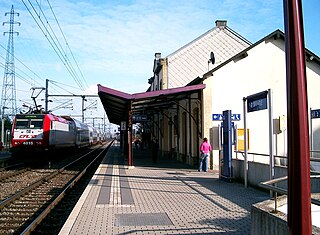
Rodange railway station is a railway station serving Rodange, in the commune of Pétange, in south-western Luxembourg. It is operated by Chemins de Fer Luxembourgeois, the state-owned railway company.

Pétange railway station is a railway station serving Pétange, in south-western Luxembourg. It is operated by Chemins de Fer Luxembourgeois, the state-owned railway company.
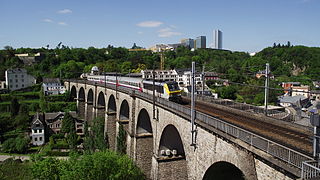
Line 10 is a Luxembourgish railway line connecting Luxembourg City to the centre and north of the country, as well as on to Liège, in Belgium. The terminus at the southern end is Luxembourg railway station, whilst the terminals at the northern end are Diekirch, Wiltz, Troisvierges and Liège. It is designated and predominantly operated by the Société Nationale des Chemins de Fer Luxembourgeois (CFL).

The National Rail Transportation Company is Algeria's national railway operator. The SNTF, a state-owned company, currently has a monopoly over Algeria's rail network of 3,973 km (2,469 mi), although it is currently utilising only 3,572 km (2,220 mi). Out of the total railway network, 2,888 km (1,795 mi) are 1,435 mmstandard gauge and 1,085 km (674 mi) are 1,055 mm narrow gauge.

There are currently no functioning railways in Haiti, and there have never been any rail connections with the neighbouring Dominican Republic. However, between 1876 and the 1970s, various tramways and railways ran in the country. A tram network operated in the capital, Port-au-Prince, between 1897 and 1932. Three railway lines, along with some industrial lines, constituted the Haitian national rail network. The first horse drawn street tramway opened in 1876, with rural railways constructed later.

Tourism in Luxembourg is an important component of the national economy, representing about 8.3% of GDP in 2009 and employing some 25,000 people or 11.7% of the working population. Despite the 2008–2012 global recession, the Grand Duchy still welcomes over 900,000 visitors a year who spend an average of 2.5 nights in hotels, hostels or on camping sites. Business travel is flourishing representing 44% of overnight stays in the country and 60% in the capital, up 11% and 25% between 2009 and 2010. Published by the World Economic Forum in March 2011, the Travel and Tourism Competitiveness Report puts Luxembourg in 15th place worldwide, up from 23rd place in 2009.
Luxembourg has a rich history of narrow-gauge railways. A few industrial and mining railways survive.

The Blochausen Ministry was the government of the Grand Duchy of Luxembourg from 26 December 1874 to 20 February 1885. It was led by Baron Félix de Blochausen.

The Servais Ministry was in office in Luxembourg from 3 December 1867 to 26 December 1874. It was reshuffled four times.
The Simons Ministry was in office in Luxembourg from 23 September 1853 to 26 September 1860. Initially it just consisted of three members of the government, to which two more were added on 23 September 1854.

Pfaffenthal-Kirchberg railway station is a rail station on CFL Line 10, in the north of Luxembourg City which opened in December 2017. It is located on Rue Saint-Mathieu in the Pfaffenthal valley, below the Grand Duchess Charlotte Bridge, overlooking the Alzette River. The Société Nationale des Chemins de Fer Luxembourgeois (CFL), the state-owned rail company, operates both the station and the associated funicular line, which links the station to the Kirchberg plateau.
Events in the year 1872 in Belgium.
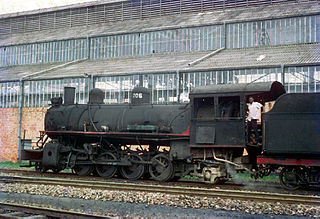
The Compagnie du chemin de fer du bas-Congo au Katanga (BCK) was a railway operator in the Congo Free State, Belgian Congo and later in the Democratic Republic of the Congo and Zaire. Most of the lines were in the southern Katanga Province, with links to the Kasai River for transport of mineral exports down to Kinshasa and onward to the port of Matadi, and a link to the Angolan railway network for transport to Lobito on the Atlantic.
The Société royale grand-ducale des chemins de fer Guillaume-Luxembourg or "Royal Grand Ducal William-Luxembourg Railway Company", was a Luxembourgish company, with French capital, created in 1857 to operate the 1855 concessions for the railway lines in the Grand-Duchy of Luxembourg. It constructed a set of lines that made up the railway network called the Guillaume-Luxembourg network. It was never an operating company, transferring this activity to a French company, the Compagnie des chemins de fer de l'Est, then to the Imperial Railways in Alsace-Lorraine in 1872, to the Administration des chemins de fer d'Alsace et de Lorraine in 1919, and then to the SNCF in 1938. During the German occupation in World War II, the Deutsche Reichsbahn operated the network until the liberation; the Guillaume-Luxembourg company ceased to exist as such in 1946 with the creation of the Société nationale des chemins de fer luxembourgeois.
{{cite encyclopedia}}: CS1 maint: location missing publisher (link)